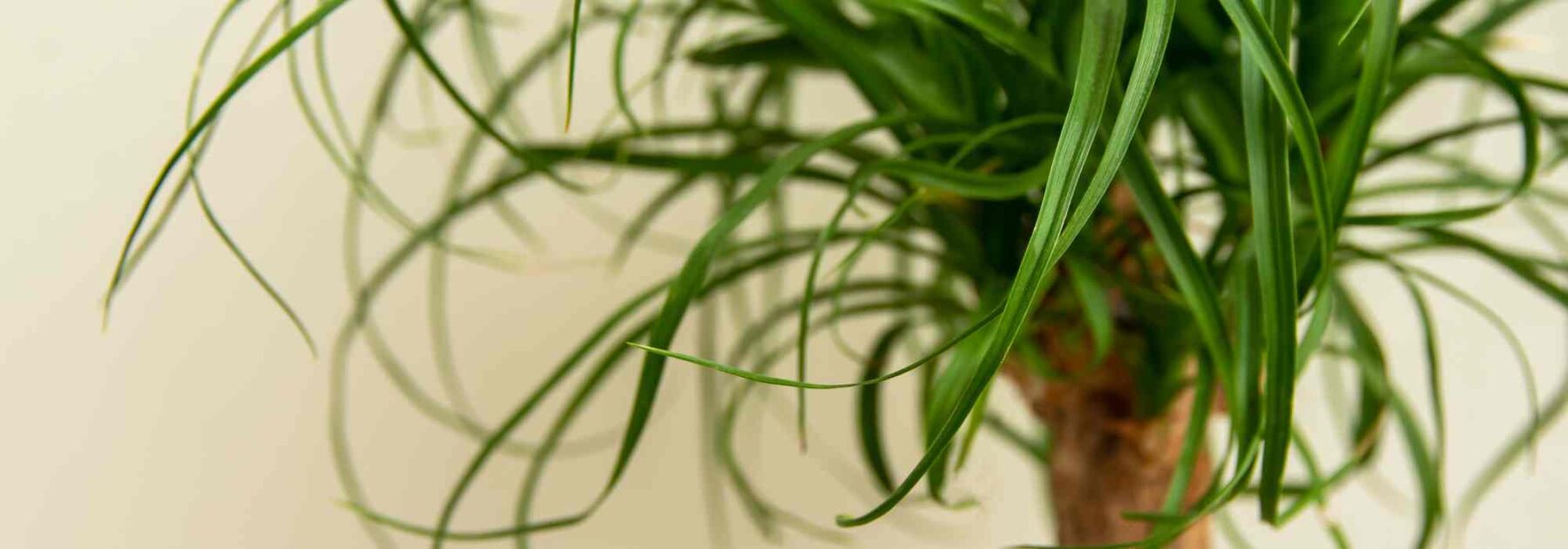
Elephant's Foot - Beaucarnea: Growing and Care Guide
Contents
The Elephant's Foot in a few words
- The Elephant’s Foot is a striking and resilient plant, native to Mexico.
- Its swollen trunk stores water, allowing it to withstand occasional neglect in watering.
- The Beaucarnea thrives in bright light and well-drained soil but dislikes excessive moisture.
- Rarely affected by diseases, it may occasionally fall prey to scale insects when kept indoors.
- Perfect for pot cultivation, it adds an exotic and elegant touch to any type of decor.
The word from our expert
The Beaucarnea recurvata, commonly known as the Ponytail Palm, is a highly popular houseplant prized for its distinctive swollen trunk and cascading foliage. Native to Mexico, this plant belongs to the Asparagaceae family and has perfectly adapted to arid environments thanks to its ability to store water in its bulbous base. Its elegant and sculptural silhouette makes it an ideal choice for adding an exotic and designer touch to any interior.
Easy to care for, the Ponytail Palm requires moderate watering and well-draining soil to avoid excess moisture, which could be fatal. It thrives in bright light and tolerates occasional neglect, making it a perfect plant for busy plant enthusiasts. Indoors, it grows slowly and can reach 1.5 to 2 metres in height over twenty years, while outdoors, in warm climates, it can exceed 5 metres and produce spectacular panicle flowers.
Rarely affected by diseases, it can nevertheless fall victim to mealybugs or spider mites, especially in dry conditions. Regular monitoring and cleaning of the foliage are usually sufficient to prevent these issues. Propagation by seeds or cuttings from offsets is possible, although the growth of young plants is very slow and requires patience.
In terms of decoration, the Beaucarnea fits seamlessly into modern, bohemian, or minimalist interiors. A terracotta, concrete, or matte ceramic pot highlights its massive trunk and enhances its graphic appeal. If the climate allows, it can be planted outdoors in perfectly draining soil, particularly on the French Riviera or the Mediterranean coast. Resilient, elegant, and low-maintenance, the Ponytail Palm is an ideal plant for combining aesthetics with simplicity of care.
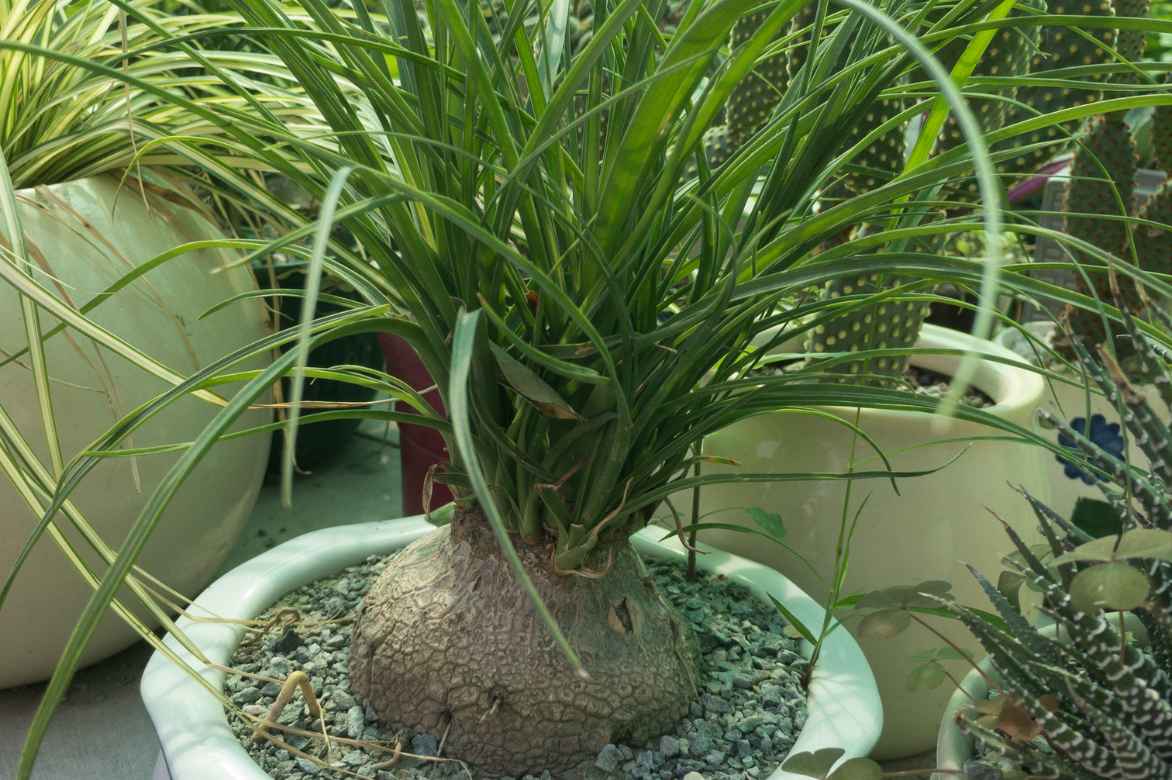
Beaucarnea recurvata
Botany and Description
Botanical data
- Latin name Beaucarnea recurvata
- Family Asparagacées
- Common name Pied d'éléphant
- Flowering juillet - août
- Height 1 m
- Sun exposure lumineux, sans soleil direct
- Soil type substrat drainant
- Hardiness -5°C
The Elephant’s Foot, also known as Beaucarnea recurvata, belongs to the botanical family Asparagaceae, like garden asparagus or indoor asparagus fern. Its genus name, Beaucarnea, was given in honour of the French botanist Jean-Baptiste Beaucarne, a passionate lover of exotic plants. In French, this plant is commonly known by several names: Elephant’s Foot, due to its swollen trunk resembling a massive leg, or Nolina, an old botanical name still occasionally used.
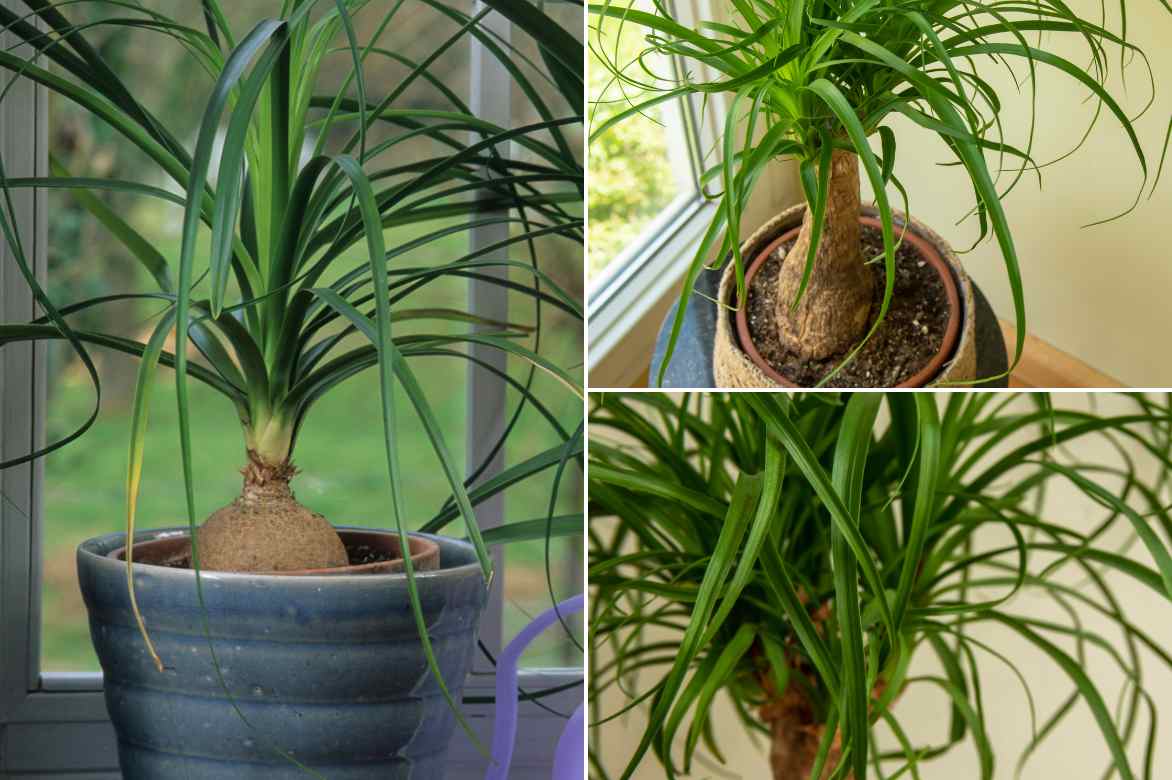
Young Beaucarnea: the trunk and foliage slowly thicken over the years
In its natural habitat, mainly in Mexico and some regions of Central America, the Beaucarnea grows in arid environments, often on rocky and well-drained soils. Its bulbous trunk, which acts as a water reservoir, allows it to survive long periods of drought, a perfect adaptation to these harsh conditions.
It is precisely this ability to store water that makes it an ideal houseplant. Low-maintenance, it tolerates missed waterings and adapts well to bright interiors, with elegant cascading foliage that adds an exotic and decorative touch. Its slow growth and sculptural appearance appeal to both plant enthusiasts and interior decorators. The Elephant’s Foot can be planted directly in the ground on the French Riviera and the Mediterranean coast in well-drained soil.
Among the cultivated species and varieties, the most common is undoubtedly Beaucarnea recurvata, recognisable by its thick trunk and long, arching leaves. But other species, such as Beaucarnea gracilis, with a more slender habit, or Beaucarnea stricta, with stiffer, upright leaves, are also cultivated, although rarer as houseplants.
The Beaucarnea, or Elephant’s Foot, generally has an upright habit, with a massive trunk at the base that gradually tapers towards the top. Over the years, this trunk develops a rough and fissured appearance, enhancing its resemblance to a miniature baobab.
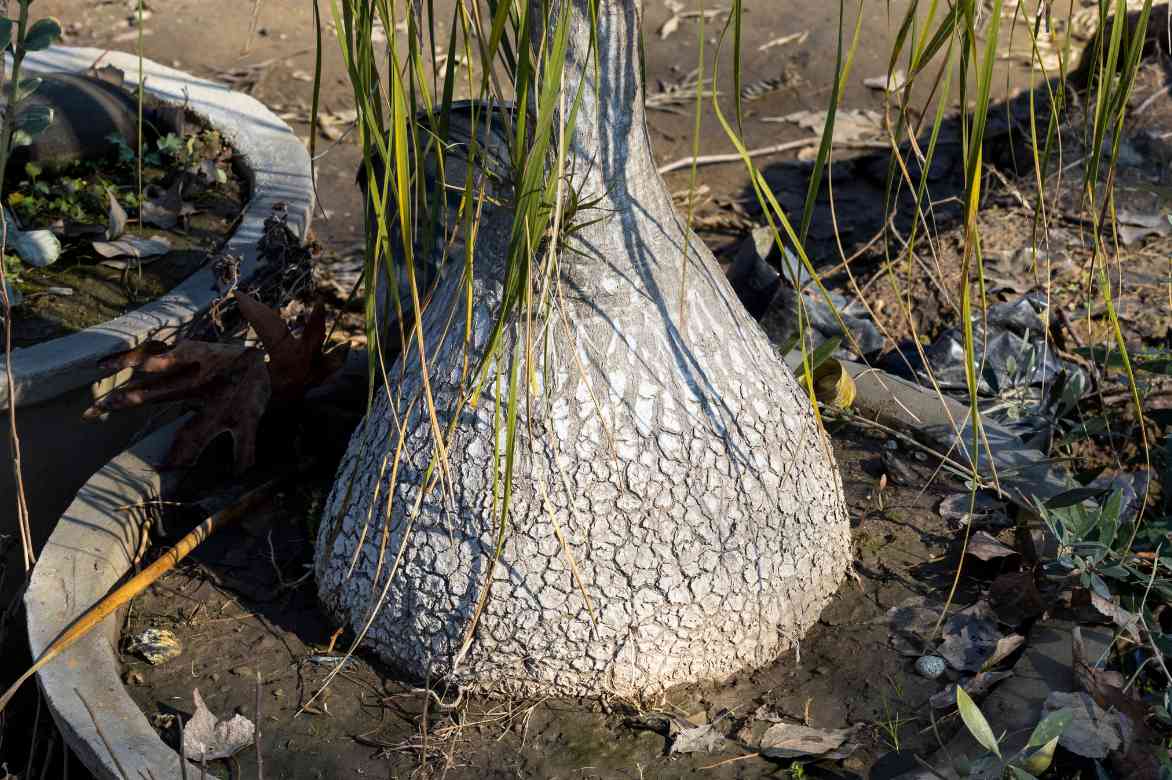
The Elephant’s Foot lives up to its nickname
Its root system is relatively shallow but well-spread, allowing it to quickly absorb available water while remaining firmly anchored in the soil. This adaptation is particularly effective in its natural habitat, where rainfall is rare and brief.
Branches develop only late, and even then, only in older specimens or after pruning that stimulates their growth. In young plants, the trunk often remains single, topped with a tuft of long, cascading leaves that form a waterfall of greenery. These leaves, narrow and flexible, ranging from bright green to slightly bluish depending on growing conditions, grow into fine ribbons that can reach a metre in length. They give the plant a lightness and movement that contrasts with the robustness of the trunk.
In its natural environment or after many years of cultivation, the Beaucarnea can produce a spectacular flowering. Large panicle inflorescences appear at the top, composed of small cream-white to yellowish flowers. These slightly fragrant flowers attract many pollinators in their native environment. After pollination, the plant develops small, round, brownish dry fruits containing seeds. However, indoors, flowering remains exceptional and rarely observed.
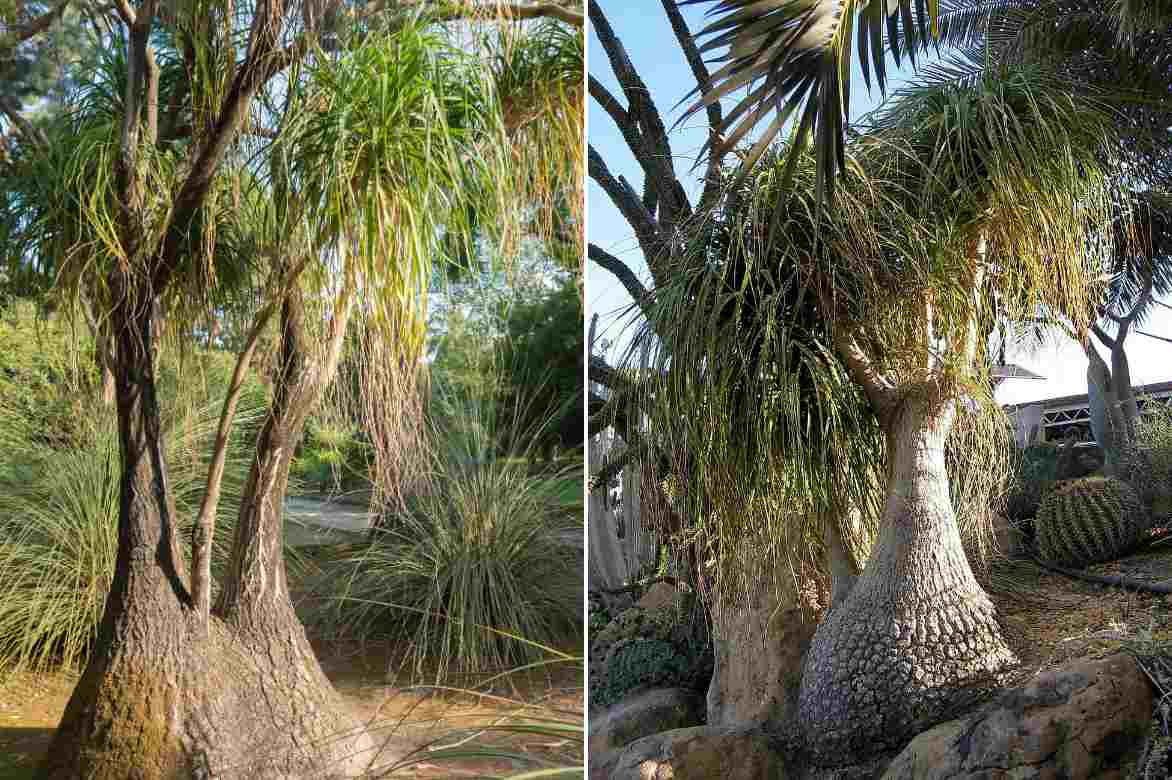
In their natural habitat, Beaucarnea reach incredible sizes and trunk dimensions!
When and How to Plant an Elephant's Foot in a Pot?
The best time to plant or repot an elephant’s foot plant is in spring, when the plant resumes its growth. Repotting can also be done in summer if necessary, but it is best to avoid autumn and winter, periods of vegetative rest.
Which substrate to choose?
The elephant’s foot plant prefers a light, well-draining, and low-organic soil, slightly acidic, similar to the arid environments where it naturally grows. An ideal mix consists of:
- 50% cactus and succulent compost,
- 30% coarse sand or perlite for good drainage,
- 20% garden soil or light universal compost.
To prevent water stagnation, it is advisable to add a layer of clay pebbles or gravel at the bottom of the pot.
Where to place your elephant’s foot plant?
- Exposure: place it in a very bright spot, near a well-exposed window (preferably south or west-facing). It can tolerate some direct sunlight, but it is best to avoid scorching rays in mid-summer.
- Temperature: it thrives in a temperate indoor environment, between 18 and 25°C, but can withstand drops to 10°C in winter.
- Humidity: it tolerates dry indoor air well and does not require high humidity. There is no need to mist its foliage.
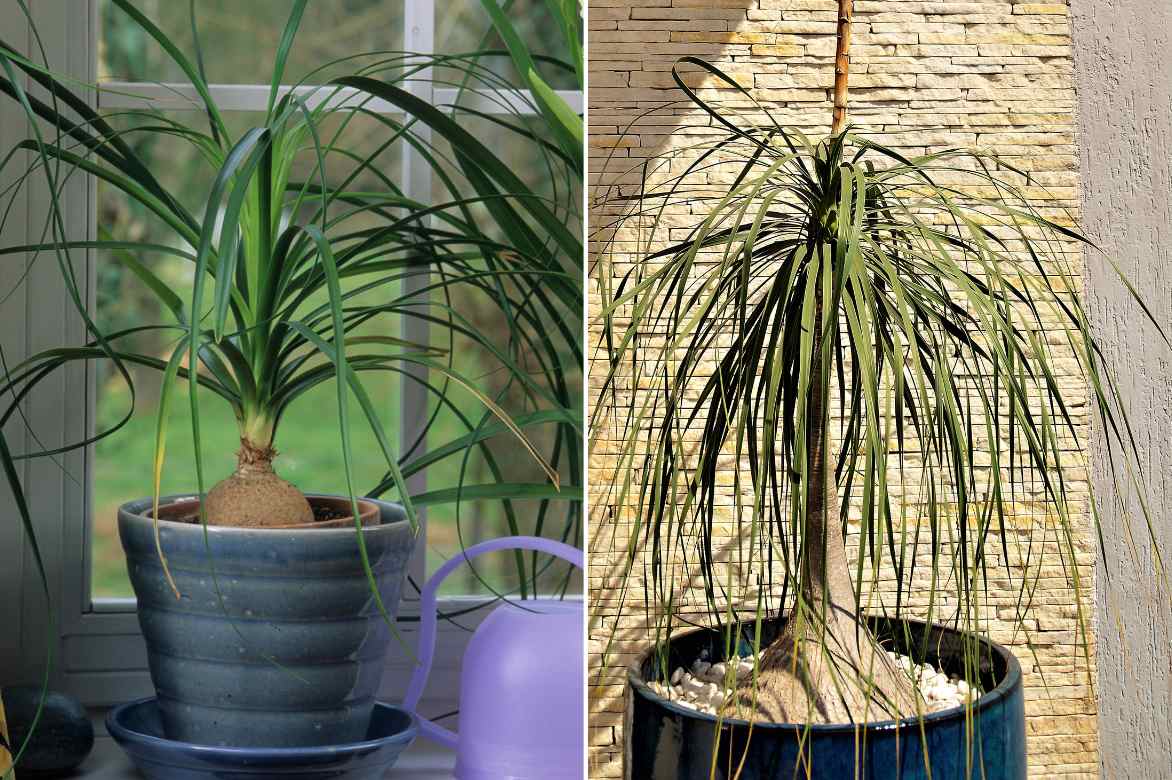
A bright and sunny exposure is essential
Which pot to choose?
- Size: the pot should be slightly wider than the base of the trunk, but not too large or deep, as the elephant’s foot plant grows slowly and prefers to be slightly root-bound.
- Material: a terracotta pot is ideal, as it allows better evaporation of moisture and reduces the risk of root rot. Ensure it has drainage holes to prevent waterlogging.
How to plant an elephant’s foot plant in a pot?
- Prepare the pot: place a layer of clay pebbles or gravel at the bottom to improve drainage.
- Fill with substrate: pour a mix of cactus compost and sand/perlite.
- Position the plant: gently remove the elephant’s foot plant from its pot and place it in the centre of the new pot. Ensure the swollen base of the trunk is not buried and remains slightly above the substrate.
- Add more substrate: fill around the plant with soil, lightly firming it to stabilise the plant.
- Water moderately: a light watering after planting is sufficient. Then, allow the soil to dry out completely before watering again.
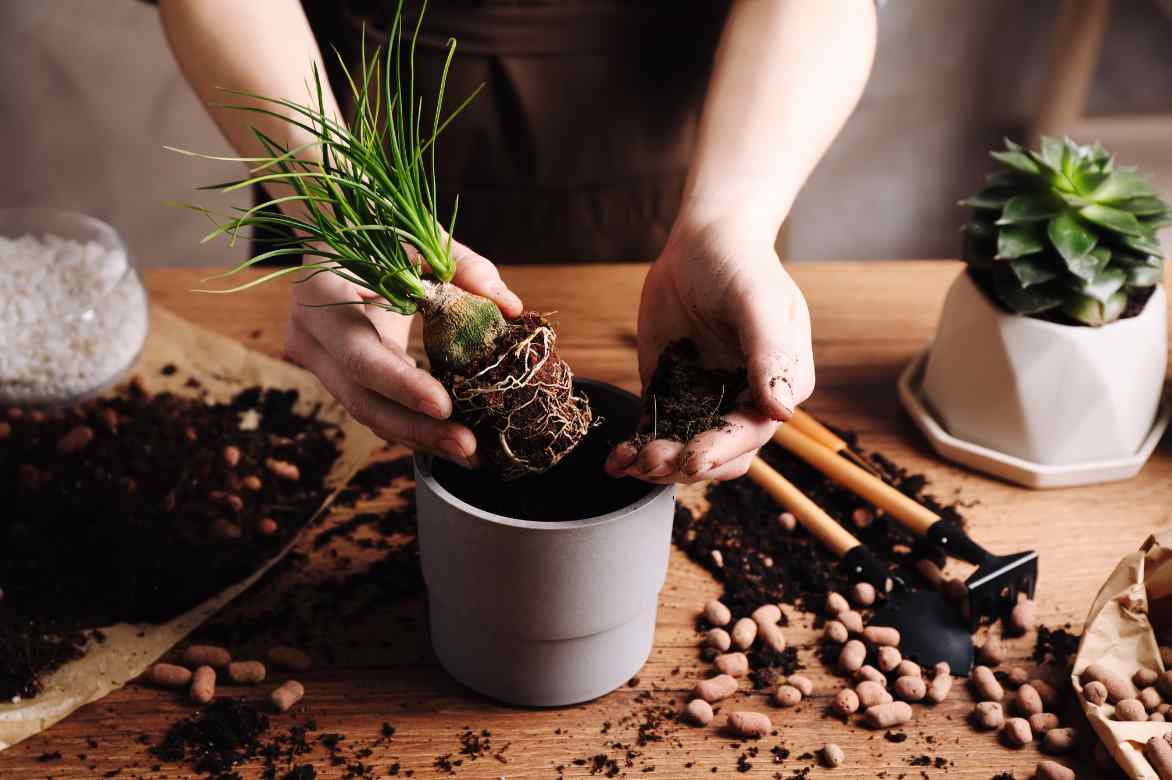
Carefully prepare your well-draining substrate, lightened with a base of clay pebbles
Repotting the elephant’s foot plant
The elephant’s foot plant grows slowly and only needs repotting every 3 to 4 years, when its roots completely fill the pot. To repot, follow the same steps as for planting, choosing a pot only slightly larger to avoid excess moisture. This is also an opportunity to refresh the substrate, providing the plant with fresh, well-draining soil.
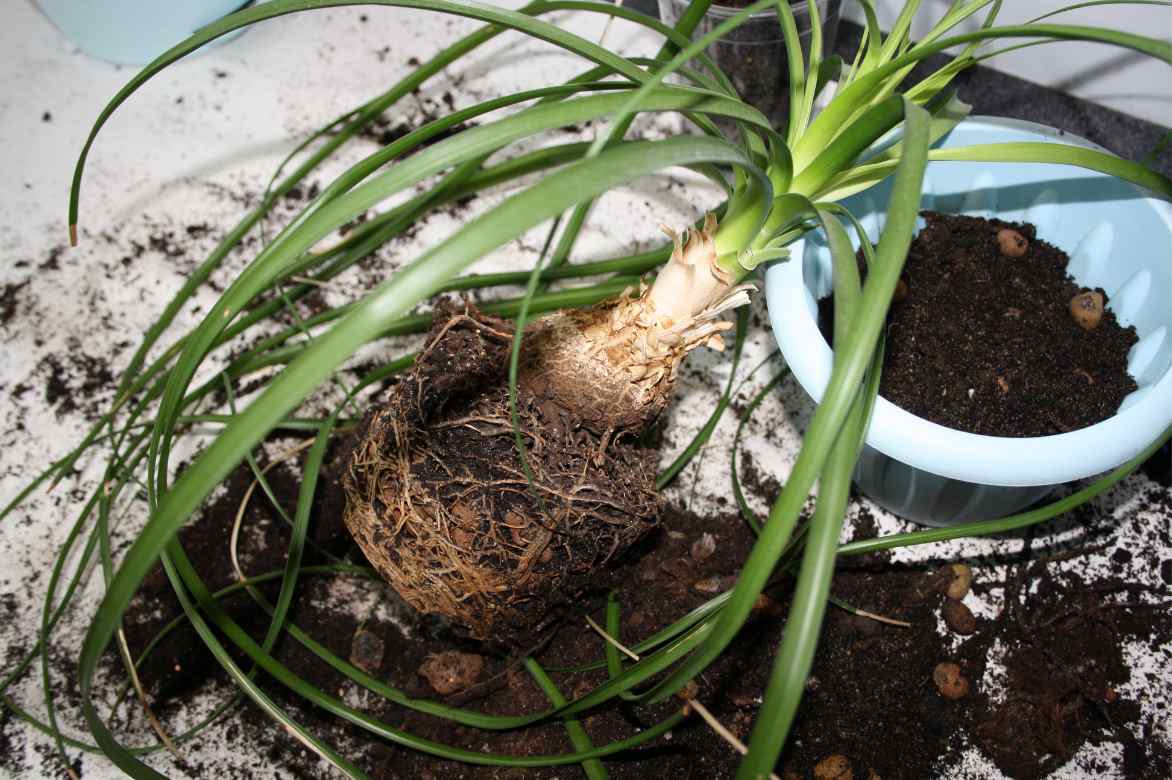
Repot when the roots have filled the entire pot
Planting a Beaucarnea in the ground
In warmer regions where frost is rare, the Beaucarnea recurvata can be grown in the ground, provided the soil is perfectly drained. Excessive winter moisture, as well as heavy rainfall, could be fatal. This is why outdoor cultivation is only feasible on the French Riviera, the Mediterranean coast, or in the far south-west of the country.
Cultivation and Care of Beaucarnea The Beaucarnea, commonly known as the Ponytail Palm or Elephant's Foot, is a striking and low-maintenance plant that adds a touch of exotic flair to any indoor or outdoor space. Native to Mexico, this resilient plant is well-suited to a variety of environments and is particularly popular among gardeners for its unique appearance and easy care requirements. **Light Requirements:** Beaucarnea thrives in bright, indirect light. While it can tolerate some direct sunlight, prolonged exposure to harsh rays may scorch its leaves. If grown indoors, place it near a south or west-facing window to ensure it receives ample light. **Watering:** One of the most appealing aspects of the Beaucarnea is its drought tolerance. The plant stores water in its bulbous base, allowing it to withstand periods of dryness. Water sparingly, allowing the soil to dry out completely between waterings. Overwatering can lead to root rot, so it's crucial to ensure proper drainage. **Soil:** A well-draining soil mix is essential for the Beaucarnea. A cactus or succulent mix works well, or you can create your own blend using regular potting soil mixed with sand or perlite to improve drainage. **Temperature and Humidity:** Beaucarnea prefers warm temperatures, ideally between 15°C and 24°C (59°F and 75°F). It can tolerate lower temperatures but should be protected from frost. The plant is not particularly fussy about humidity, making it suitable for most indoor environments. **Fertilising:** Feed your Beaucarnea with a balanced, water-soluble fertiliser during the growing season (spring and summer). Reduce feeding in the autumn and winter when the plant's growth slows down. **Pruning:** Pruning is generally not necessary for the Beaucarnea, but you can trim any brown or damaged leaves to maintain its appearance. Use clean, sharp scissors or pruning shears to avoid damaging the plant. **Repotting:** Beaucarnea grows slowly and does not require frequent repotting. Repot every 2-3 years or when the plant becomes root-bound. Choose a pot that is slightly larger than the current one and ensure it has adequate drainage holes. **Pests and Diseases:** Beaucarnea is relatively pest-resistant but can occasionally be affected by spider mites or mealybugs. Regularly inspect the plant and treat any infestations promptly with insecticidal soap or neem oil. By following these simple care guidelines, your Beaucarnea will thrive and continue to be a stunning focal point in your garden or home. Its unique shape and minimal care requirements make it an excellent choice for both novice and experienced gardeners alike.
Watering
Watering should be spaced out and measured. In spring and summer, during its growth period, watering once every 15 days is sufficient, allowing the substrate to dry out on the surface between waterings. In autumn and winter, when the plant enters dormancy, watering should be spaced out even more, sometimes to once a month, or even less in a cool environment. Too much water can lead to root and trunk rot, one of the main causes of failure with this plant.
Fertilisation
In terms of fertilisation, the Beaucarnea has no special requirements. A monthly application of a low-nitrogen liquid fertiliser (such as bonsai fertiliser) in spring and summer can be beneficial to stimulate its growth, but it is best not to overfeed the plant. Too many nutrients could encourage excessive foliage growth at the expense of the trunk and swollen base.
Pruning
Pruning is generally not necessary, but it can be done if you want to encourage branching. Cutting the tip of the trunk or young shoots can stimulate the appearance of new branches, although the Beaucarnea naturally has slow growth and a tendency to remain single-stemmed for many years.
Precautions
However, the elephant’s foot is sensitive to cold drafts and excessive ambient humidity. Finally, as its leaves are long and thin, they can accumulate dust; regular cleaning with a damp cloth or a light shower helps maintain healthy and attractive foliage.
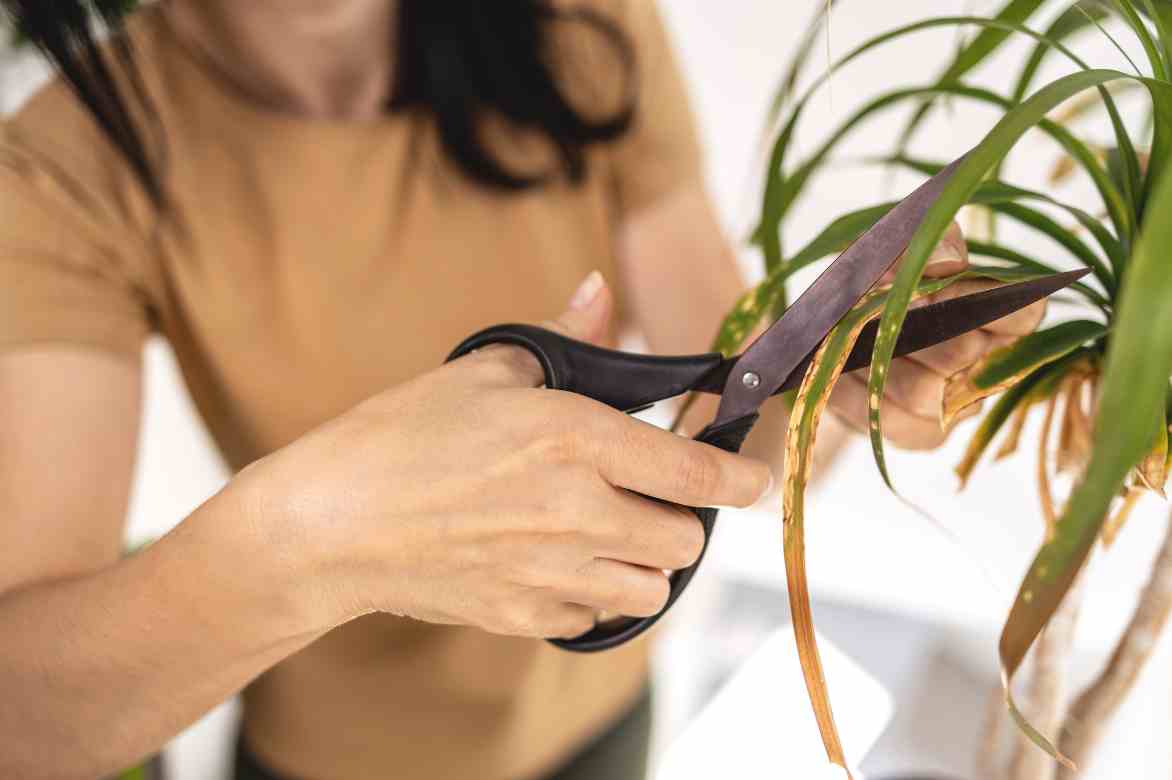
Minimal maintenance for the Elephant’s Foot, except for trimming dried tips
Potential Diseases and Pests
Diseases
The main enemy of the Beaucarnea indoors is excess moisture, which promotes root and trunk rot. If the substrate remains waterlogged for too long, the swollen base may become soft, a sign of a fungal attack. In this case, it is essential to drastically reduce watering, repot the plant in a well-draining substrate and, if necessary, apply a fungicide.
Finally, a Beaucarnea that loses its leaves en masse or has browned tips usually suffers from a watering problem (excess or lack), an atmosphere that is too dry, or a lack of light. Fortunately, correcting the growing conditions is often enough to restore it to health.
Pests
Among the pests, mealybugs and scale insects are the most common. They nest under the leaves or on the trunk, forming small cottony masses or hard brown patches. Their presence weakens the plant and causes yellowing of the foliage. To get rid of them, manual cleaning with a cloth soaked in 70° alcohol, followed by treatment with black soap, is effective.
Spider mites can also appear when the air is too dry, especially in winter with heating. They cause yellowing and gradual drying of the leaves. Increasing ambient humidity by spraying with non-calcareous water often helps to limit their development.
Multiplication of Beaucarnea
Propagating a Beaucarnea recurvata is not always easy, but there are two main methods: sowing seeds and taking cuttings from offsets, although the latter is more delicate.
Sowing
Sowing seeds is the most common method, although germination requires patience. The seeds must be fresh and soaked for 24 hours in lukewarm water before being sown in a light, well-draining substrate composed of potting soil and sand. It is important to maintain a temperature of around 25°C and consistent humidity, without waterlogging the substrate. Germination can take several weeks to several months. Once the seedlings appear, they should be gradually acclimatised to normal growing conditions.
Caution!: Harvesting Beaucarnea seeds is rare indoors, as the plant takes several decades to flower and requires cross-pollination between a male and female plant. If fertilisation is successful, it produces small dry fruits containing seeds, which should be harvested once fully ripe and dry before being sown.
Cuttings
Taking cuttings from offsets is an option if the mother plant produces them, which is not always the case indoors. These offsets, which grow at the base of the trunk, can be removed with a sharp knife when they reach a sufficient size (about 10 cm). It is advisable to let them dry for a few hours to avoid infections before planting them in a slightly moist sandy substrate. Adding a rooting activator can improve the chances of rooting, but the process remains unpredictable and success is not guaranteed.
In any case, the growth of Beaucarnea is very slow, so patience is required before obtaining a plant of appreciable size.
How to Showcase a Ponytail Palm?
The Elephant’s Foot (Beaucarnea recurvata) fits perfectly into modern, minimalist, bohemian, or exotic interiors, thanks to its sculptural appearance and cascading foliage. Its swollen trunk and elegant silhouette make it an ideal centrepiece for a refined decor or a nature-inspired space. It also finds its place in industrial settings, paired with metal and raw wood, or in a zen interior, alongside stones and natural materials.
To highlight it, it is preferable to choose a terracotta pot, which promotes moisture evaporation and enhances its desert-like character. Raw concrete pots, matte ceramic, or woven wicker baskets also add an interesting aesthetic touch. For an even more decorative effect, it can be placed in a large natural fibre planter or on a pedestal to accentuate its slender form.
In a large open terrarium, with sand, stones, and other desert plants like cacti or succulents, it can create a stunning arid-inspired composition.
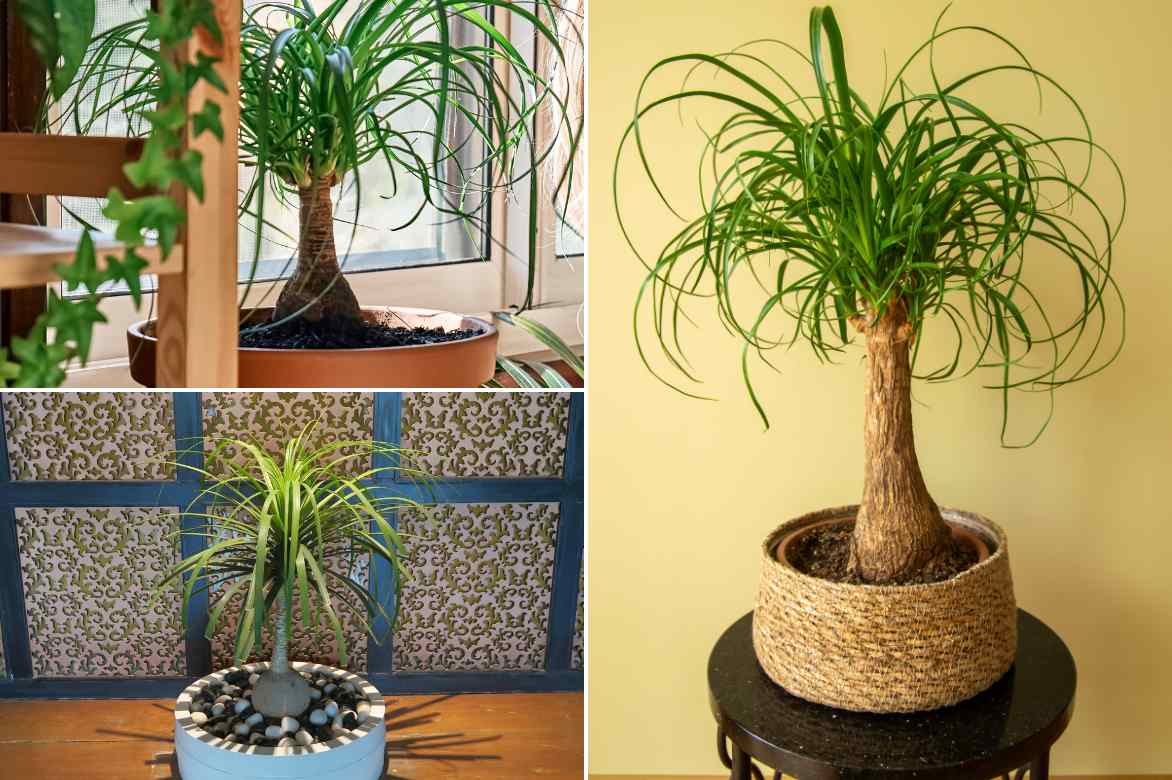
The Elephant’s Foot thrives in various settings: placed on the floor, on a side table, near a window…
See also...
→ Discover our wide range of indoor plants.
→ While many books on indoor plants exist, we recommend THE ultimate guide on the subject: The Encyclopedia of Indoor Plants by Solène Moutardier, published by Ulmer.
- Subscribe!
- Contents
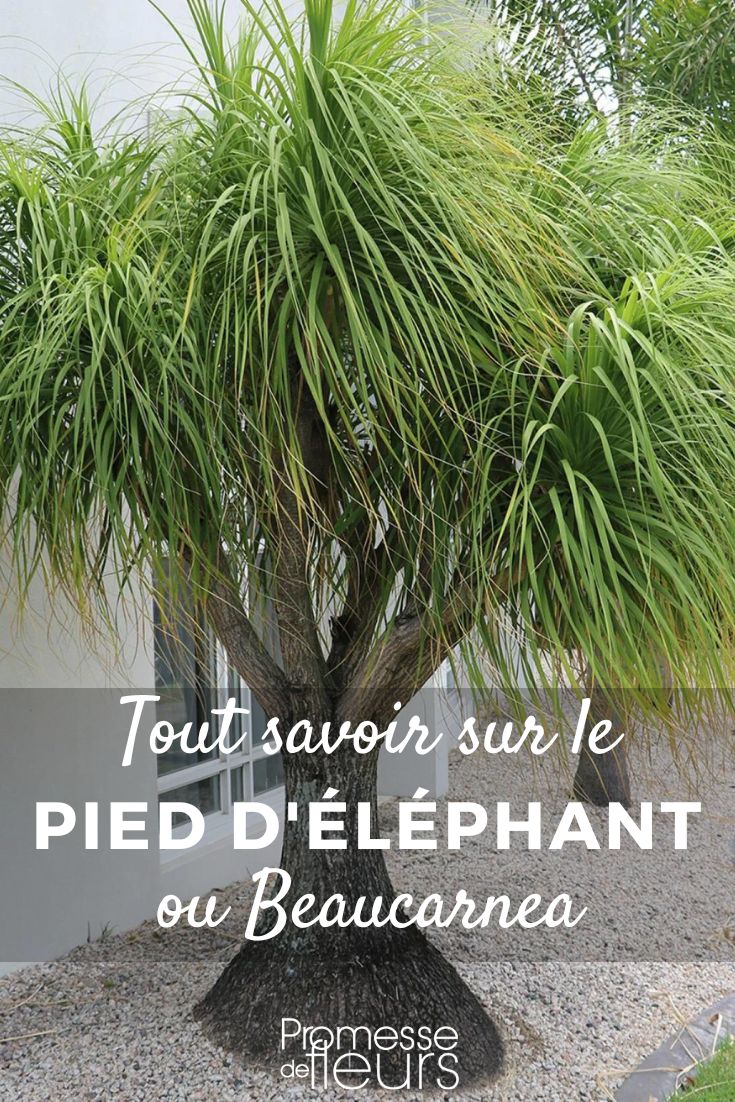


































Comments